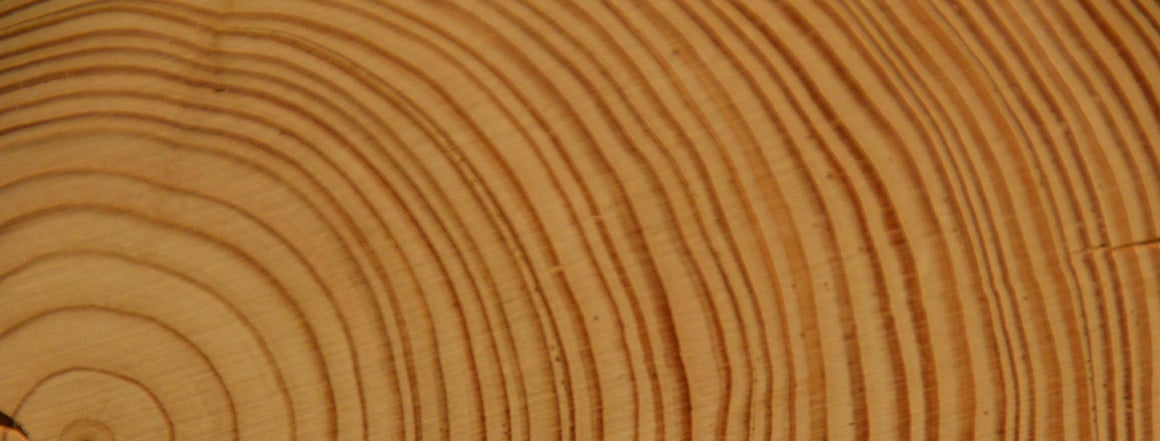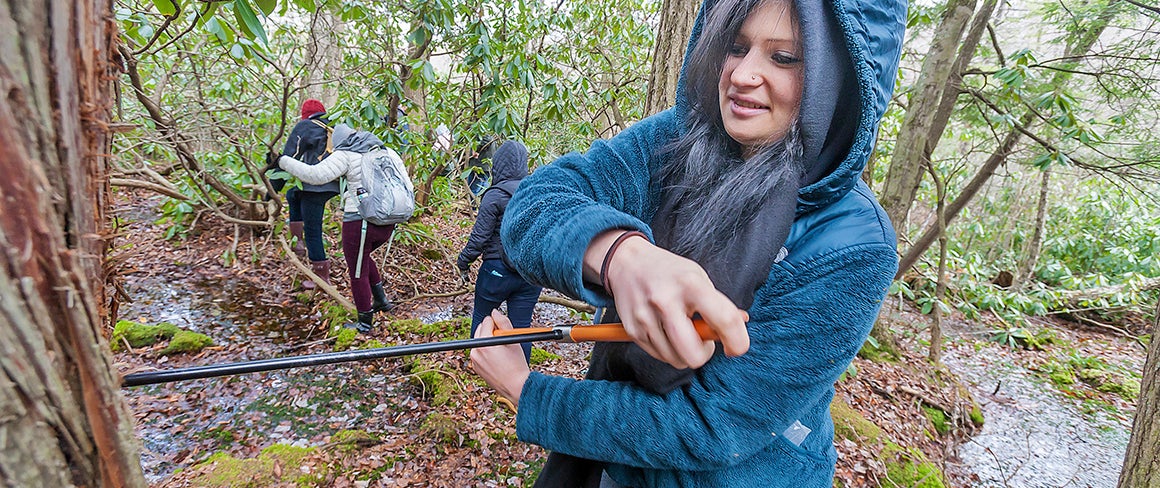Tree Rings and Climate
Trees contain some of nature's most accurate evidence of the past. Their growth layers, appearing as rings in the cross section of the tree trunk, record evidence of disastrous floods, insect attacks, lightning strikes, and even earthquakes that occurred during the lifespan of the tree. They also hold excellent records of climate.
Each year, a tree adds to its girth, the new growth being called a tree ring. The most recently formed tree ring is the new wood near the outer part of a tree's trunk, just beneath the bark. The oldest rings are smaller and near the center. Trees that grow in mid- to high-latitude regions form rings that are easy to spot because they have a distinct growing season when a light colored ring forms. As growth slows in the late summer or fall, wood forms more slowly and is darker in color.

Cross section of a tree trunk showing alternating light and dark layers of the tree rings
Credit: Pixabay
Tree growth depends upon local environmental conditions. In some areas the limiting factor for growth is water availability, in other areas (especially at high latitudes) it is the length of the growing season. In areas where water is limited and the amount of water varies from year to year, scientists can use tree-ring patterns to reconstruct regional patterns of drought. In areas where the length of the growing season is the limiting factor, the thickness of tree rings can indicate when growing seasons were longer (during warmer times) and when growing seasons were shorter (cooler times).
The study of the growth of tree rings is known as dendrochronology. The study of the relationship between climate and tree growth in an effort to reconstruct past climates is known as dendroclimatology.
A tree ring, representing one year, consists of two layers:
- A light colored layer which forms in the spring and early summer, which is typically thicker because the tree is growing.
- A dark colored layer which forms in late summer and fall, which is typically thinner because the trees growth slows.
Tree ring data is only collected outside of the tropics. Trees in temperate latitudes have annual spurts of growth in the spring and summer and periods of dormancy in the winter, which creates the distinctive pattern of light and dark bands. Tropical trees grow year-round, and so they do not have the alternating dark and light band pattern of tree rings.
At locations where tree growth is limited by water availability, trees will produce wider rings during wet and cool years, than during hot and dry years. Drought or a severe winter can cause narrower rings too. If the rings are a consistent width throughout the tree, the climate was the same year after year. By counting the rings of a tree, we can pretty accurately determine the age and health of the tree and the growing season of each year.

This scientist is extracting a core from a living tree using an increment borer. This process does not cause long term harm to the tree.
Credit: SERC/Tree-Ring Expeditions
Scientists do not typically cut down a tree to analyze its rings. Instead, core samples are extracted using a borer that's screwed into the tree and pulled out, bringing with it a straw-size sample of wood about 4 millimeters in diameter. The hole in the tree is then sealed to prevent disease.
Collecting core samples from many trees in an area and the data from the tree rings is averaged to reduce the influences of a trees' specific location - such as being in the shade or near a stream - and be able to see widespread patterns. Because different tree species grow at different rates depending on the temperature, precipitation, and other factors, data from different tree species can provide even more information about climate than data from only one species.
Old trees tell us about conditions on Earth long before people started measuring and recording the weather. Some tree species, such as the bristlecone pine, that live for several thousand years, contain long records of tree rings. However, climate scientists typically work with trees that are not so long-lived and extend their tree ring records back more than 10,000 years by comparing ring patterns of living trees with the rings in dead but not-yet-decayed trees that have fallen. Scientists match patterns from the early stages of a living tree's rings with the sequence formed in the latter parts of the lives of older, dead trees to assemble an unbroken paleoclimate record extending back thousands of years.
Beams from old buildings or ruins, samples from wooden frames of old paintings, and the wood from violins have all been used to add tree ring samples to climate records. In some cases, much older tree rings in petrified wood have been analyzed to interpret what the climate was like hundreds of thousands to millions of years ago.

Tree rings in these seven cores don't look round like rings because the boring tool only extracts a small segment of the rings. Each dark and light layer makes up a year of growth. Wide layers indicate years when the trees grew more. Narrow layers indicate years when the trees grew less. These cores are from white spruce trees in Alaska.
Credit: SERC/Tree-Ring Expeditions